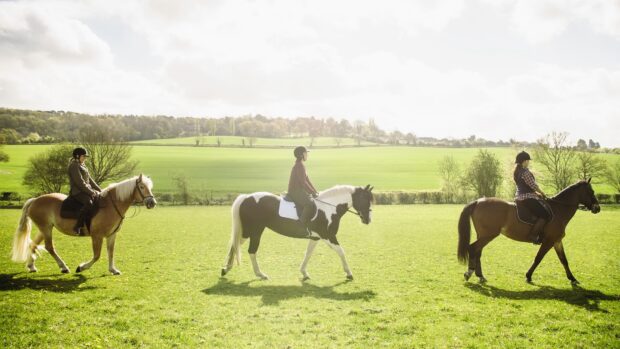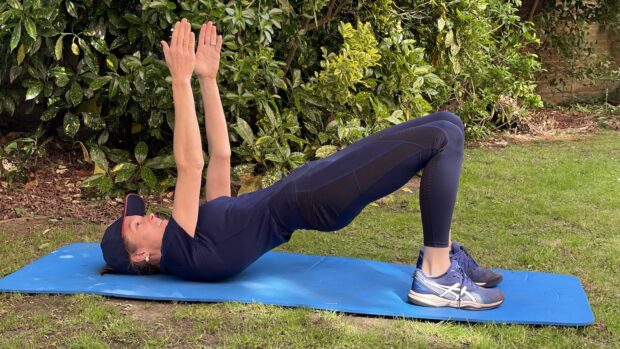What if I told you there’s a breathing exercise for riders that’ll help you unlock your potential in the saddle and beyond? Like for most equestrians, improving my riding technique is a major priority. However, we in the equestrian community are typically pushed for time with tasks in all areas mounting up – most days there’s barely time for a cuppa, let alone a workout. I found myself thinking: “Can I work on my riding while going about my normal day?”
What is diaphragmatic breathing?
According to APCAT chartered physiotherapist Maeve Sheridan, tapping in to the power of the diaphragm could be the key. “The diaphragm, deep abdominal muscles and pelvic floor all work together to regulate our breathing,” she tells H&H. “Your diaphragm is the parachute shaped muscle under your lungs, it’s the main muscle for breathing.”
In riding, there’s a great deal of focus on engaging the core, which equestrians usually interpret as the need to constantly tense the abdominal muscles. “What this actually does is block the diaphragm from working effectively,” says Maeve, who runs the Activate Your Seat instagram account. “We then rely on apical breathing, using the muscles of the neck and shoulders, for sustained periods. These aren’t designed to work constantly, so they can get tight and sore.”
So, how can you engage your core while breathing effectively? When you tap into optimal diaphragm function, the abdominal muscles take care of themselves.
“On inhalation, our diaphragm contracts and moves down to allow our lungs to fill with air,” explains Maeve. “Your deep abdominal muscles need to relax to allow this to happen. At the same time, your pelvic floor muscles lengthen. When you breathe out, the reverse happens. Your pelvic floor and deep abdominal muscles contract to push the diaphragm back up and expel air out of your lungs.
“If we’re constantly thinking about keeping our abdominal muscles tense, that will block the full function of our diaphragm. If we train our diaphragms to work effectively, we don’t actually have to tense to activate our core. It happens all subconsciously through diaphragmatic breathing.”
A breathing exercise for riders: the diaphragm reset
The first breathing exercise for riders that Maeve uses with new clients is the diaphragm reset. “The diaphragm reset helps encourage you to use your diaphragm effectively,” she explains.
- Place your thumbs on your belly button and rest your palms on your belly. Relax your shoulders.
- Take a deep breath in through your nose, right down in the base of your lungs and into your belly. You should feel your belly expand, sides and lower back expand slightly. Then, blow out through your mouth as if you were blowing through a straw.
- Repeat two or three times.
- Imagine an upside down Y shape running from the middle of your chest and flanking your ribcage. Spend a couple of minutes tracing this shape with the pads of your fingers, starting on the edges of your ribs. Apply enough pressure to feel it, but not so it’s painful.
- Work along the edge of your ribs in to the centre of your ribcage, where the muscles can be tight, and then up your sternum all the way to the edges of your collarbones. Then, work your way back down. Spend a few minutes doing this.
- Try the breathing exercise again – in through your nose and out through your mouth. You should find it easier to activate your diaphragm. Think of air filling the base of your lungs in 360°, so the front, sides and back of the ribcage expand to allow this, then flatten as you blow the air our through your mouth. Aim to repeat for 20 breaths.
Maeve adds: “You can try the diaphragm reset anywhere, including in the saddle, but it’s a great exercise to practise last thing at night, while laying in bed. This is because the slow, controlled breaths help us transition from a sympathetic nervous system (fight and flight) state to a more parasympathetic nervous system (rest and digest) state.”
Horse&Hound’s verdict
At first, the diaphragmatic reset felt completely alien – it just goes to show how subconscious processes like breathing are. On my initial tries, it felt impossible to inhale for more than three or four seconds and I felt I was barely inflating my belly. It was also hard to keep my shoulders relaxed at first and I had to really think about it. By the middle of the week, though, I could breathe in for five counts comfortably before even rubbing the upside-down Y shape zone of my chest and ribs, and now I’m closer to eight counts.
Like with anything new, you shouldn’t expect overnight changes – but even after a week, I’ve noticed positive benefits from daily diaphragmatic breathing.
For starters, I’m falling asleep faster and more easily. A couple of times I’ve not even made it to 20 breaths before I’ve nodded off! Diaphragmatic resets are so easy to fit around my routine that I’ve performed some at my desk, too. I have found it really helps me keep on top of shoulder tension, which can only help my posture while seated and in the saddle.
It’s so easy to do diaphragmatic resets while hacking and in recovery periods during schooling sessions – I just take one hand off the rein to perform the reset. Again, I’ve found the biggest benefit is releasing tension here, but I’ve also noticed that I feel as though my seat has deepened. In the latter stages of the week, I noticed my share horse, Lenny, was more responsive to my half-halt, and rather than killing his forward momentum like it sometimes can, he felt like he maintained the energy in this gait (especially in canter), but just briefly paused.
I haven’t noticed an improvement in my cardiovascular recovery – that might come when Lenny and I get fitter and we do some faster work and jumping – but that fact I’ve identified a few plus points in only a week makes me feel like diaphragmatic resets are absolutely worth my time. And, because I barely have to make time to do them, practising them fits in so well and makes diaphragm resets a worthwhile exercise for busy riders. I’ll definitely keep them as part of my routine.
You may also be interested in…
With many top riders now swearing by Pilates, it is clear that this exercise technique is no passing fad. Andrea

Rider fitness: what do we really mean by ‘core’ and how does it work?

Pilates for riders: exercises to try at home

Subscribe to Horse & Hound magazine today – and enjoy unlimited website access all year round
Horse & Hound magazine, out every Thursday, is packed with all the latest news and reports, as well as interviews, specials, nostalgia, vet and training advice. Find how you can enjoy the magazine delivered to your door every week, plus options to upgrade your subscription to access our online service that brings you breaking news and reports as well as other benefits.




